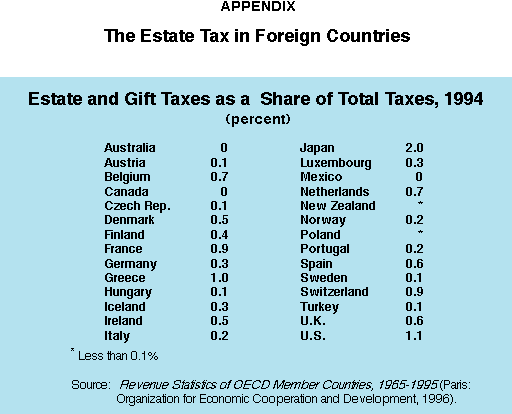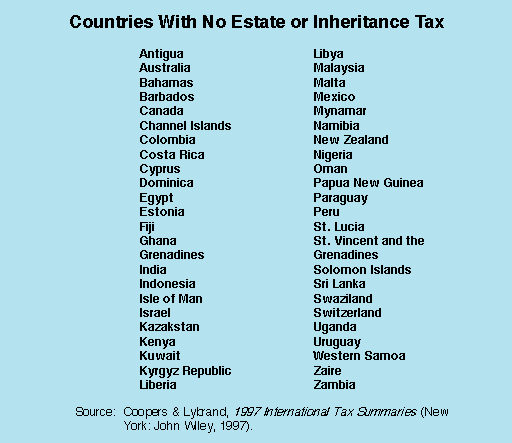The estate and gift tax is the federal government's least significant revenue source. In fiscal year 1997 it is expected to raise just $17 billion, according to the Office of Management and Budget. With total federal revenues estimated at $1.5 trillion, the tax contributes just 1.1 percent. However, while the tax is insignificant in terms of federal revenue, it is very significant economically. It wastes resources. It discourages work, saving and investment. And it does virtually nothing to equalize the distribution of wealth. For these reasons, it should be abolished.
"Much less of the tax falls on the very rich than is commonly believed."
The federal estate tax was first enacted in 1916 on estates larger than $50,000 (the equivalent of $720,000 today). The top rate was 10 percent. However, the revenue yield from the tax was small because people simply gave away their assets tax-free during their lifetimes. This led to establishment of a gift tax to augment the estate tax in 1924. Since 1976 the estate and gift taxes have been unified into one tax system. Today the tax applies to estates above $600,000. It begins at a rate of 18 percent, going up to 55 percent.1 [See Table I.] This year, just 1.66 percent of adult deaths in the United States are expected to result in taxable estates.2
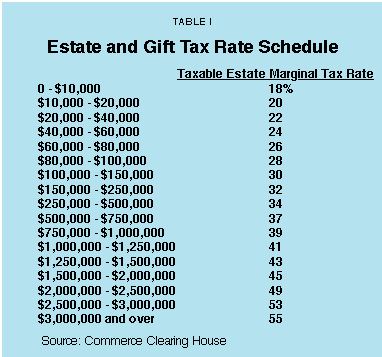
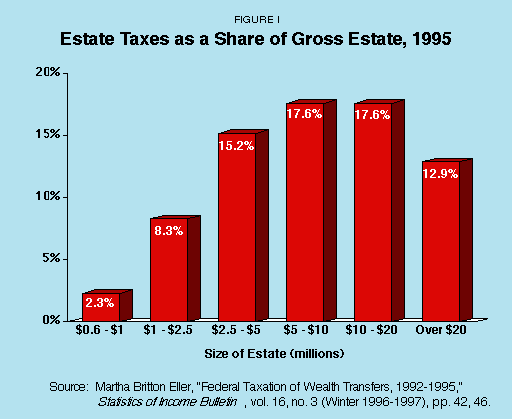
A fundamental rationale for the estate tax is that it is paid only by those who can most easily afford it; namely, the rich. However, because of legal estate planning techniques, much less of the tax actually falls on the very wealthy than is commonly believed.
- In 1995, 54 percent of all estate tax revenue came from estates under $5 million.
- And as Figure I illustrates, estate taxes as a share of gross estates actually fall for those with estates above $20 million.
"The lawful methods of avoiding the estate tax make it essentially a voluntary tax."
The reason for this disparity is that careful estate planning can virtually eliminate the tax. At the simplest level, individuals can give away up to $10,000 per year per person free of gift tax. Also, there is a large deduction for gifts made to spouses, whose estates may be taxed separately. Thus for most married couples, the estate tax only applies to estates larger than $1.2 million. Beyond that, there are a number of increasingly complex methods for reducing the burden of the estate tax. They include:
- Life insurance trusts.
- Qualified personal residence trusts.
- Charitable remainder trusts.
- Charitable lead trusts.
- Generation-skipping trusts.3
One indication of the growth of estate planning is the increase in the share of total estate and gift taxes being raised by the gift tax, as shown in Table II. By making gifts of stock or other assets during their lifetimes, any subsequent increase in their value will no longer be part of the estate.
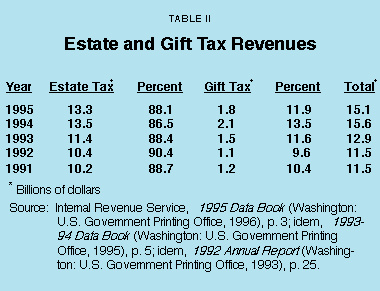
So effective are these methods of avoiding estate taxes that Professor George Cooper of Columbia University says that the estate tax essentially is a voluntary tax. As he wrote, "The fact that any substantial amount of tax is now being collected can be attributed only to taxpayer indifference to avoidance opportunities or a lack of aggressiveness on the part of estate planners in exploiting the loopholes that exist."4 Economists Henry Aaron and Alicia Munnell put it even more bluntly. In their view, estate taxes aren't even taxes at all, but "penalties imposed on those who neglect to plan ahead or who retain unskilled estate planners."5
"A disproportionate burden of the estate tax often falls on those with recently acquired modest wealth: farmers, small businessmen and the like."
However, as Figure I makes clear, the ability to exploit existing tax-avoidance techniques is not uniform across estates. Those with the largest estates clearly have the greatest ability to engage in estate planning. This is because many estate planning techniques are costly and require long lead-times to implement. And families with long histories of wealth are more likely to be familiar with them. Thus a disproportionate burden of the estate tax often falls on those with recently acquired, modest wealth: farmers, small businessmen and the like. In many cases their incomes may not have been very high and they died not even realizing that they were "rich."
The reason those with larger estates are more likely to engage in complex estate planning is, of course, that they pay higher marginal tax rates on their assets. However, the same general principle applies to the estate tax in general. Research shows that during periods when estate tax rates were rising, revenue from the estate tax fell. Conversely, lower estate tax rates increased estate tax revenue, because it was no longer as profitable to engage in costly estate planning.6 Estate planning is costly, not just in terms of lawyers fees and the like, but also because assets placed in trust may not earn as high a rate of return as they would under the original owner's control.7
[page]"Due to the estate tax, 51 percent of family businesses would have difficulty surviving if the principal owner died."
The impact of the estate tax on small businesses can be devastating. According to a recent survey, 51 percent of family businesses would have significant difficulty surviving in the event of a principal owner's death, due to the estate tax. And 14 percent of business owners said it would be impossible for them to survive. Only 10 percent said the estate tax would have no effect.
This same survey found that 41 percent of business owners would have to borrow against equity to pay the estate tax and 30 percent said they would have to sell all or part of the business. Eighty-one percent of family businesses reported having taken steps to minimize the estate tax bite. These include purchasing life insurance, making lifetime gifts of stock, putting the business into trust or other arrangements.8
Recent academic research has also looked at the impact of the estate tax on small businesses. According to one study, its main effect is on business liquidity. Since most small businesses are undercapitalized to begin with, the estate tax can literally suck the life blood out of a business. Increasing the ability of entrepreneurs to leave an inheritance can greatly increase the chances of a small firm's survival.9 Other research found that the estate tax encourages small business owners to sell out or merge with large firms.10
[page]The impact of estate planning goes beyond the estate tax and affects the income tax as well. For example, under a charitable remainder trust one donates assets to a tax-exempt institution but retains the income from the assets until death. Not only are the assets fully shielded from the estate tax, but the charitable donation reduces one's income taxes as well. Because of such interactions between the estate tax and the income tax, Professor B. Douglas Bernheim of Stanford University believes that lost income tax revenue may offset all of the revenue from the estate tax.11
"Lost income tax revenue may offset all of the revenue from the estate tax."
While expressing some skepticism about the magnitude of the effect Bernheim identifies, Professor Edward McCaffery of the University of Southern California believes that the impact of the estate tax may be even larger for other reasons. In particular, McCaffery believes that the impact of the estate tax on economic growth may be significant, by reducing the incentive to work, save and invest. For example, he points out that if one's prime motivation is to leave a large estate to one's children, then the effective marginal tax rate on investment and labor is the income tax rate plus the estate tax rate. This rate can go as high as 73 percent at the federal level alone (39.6 percent top income tax rate plus 55 percent estate tax rate on the remainder), with state income taxes pushing it higher still. And McCaffery goes on to point out that these negative effects on saving and work effort are not limited to the very rich. Insofar as the estate tax encourages gifts to one's children during one's lifetime, it may have the effect of reducing their work and saving as well.12
Recent research indicates that the estate tax has a much greater impact on the behavior of the living than previously thought. Parents often use the promise of a bequest to influence the behavior of their children. They also may use bequests to equalize the financial well-being of their children.13 Thus the desire to leave a large estate is one of the primary motivations for working and saving later in life. To the extent that the estate tax reduces a parent's ability to leave an estate to his children, it will have a negative effect on his interest in accumulating wealth through work, saving and investing.14
[page]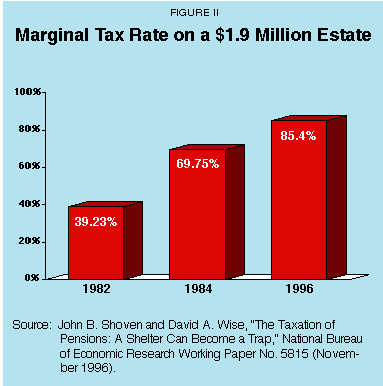
Another way in which the estate tax negatively interacts with other taxes relates to pensions. In a recent paper, Professors John B. Shoven of Stanford and David Wise of Harvard point to a little-known provision of the law that imposes a 15 percent excise tax on "excess" pension assets. This tax was enacted in 1986 and is imposed on withdrawals exceeding $155,000 per year. (At age 70, it would take only $1.2 million in assets to generate this much income in an annuity.) It is in addition to federal and state income taxes. This means that the marginal tax rate on pensions larger than $155,000 is over 61 percent – far higher than the top income tax rate of 39.6 percent.
This is bad enough, but in fact the tax burden is even higher when the estate tax is considered. Shoven and Wise point out that prior to 1982, pension assets passed through estates tax-free. Whatever money one had in an IRA at death, for example, could be passed to one's heirs free of estate tax. After 1982, only $100,000 could be given free of estate tax, and since 1984 all pension assets are taxed.
The combination of federal and state income taxes plus estate taxes and the 15 percent excise tax means that extraordinarily high tax rates can apply to pension assets in estates.
- As Figure II shows, for an estate larger than $1.9 million (in 1996 dollars), the marginal tax rate has risen from 39 percent in 1982 to over 85 percent today.
- In some states the rate can go as high as 99.73 percent!
"Even people of modest means who save and invest steadily for a lifetime can find their estates subject to confiscatory tax rates."
Shoven and Wise strongly emphasize that these tax rates are not reserved only for the very rich. Anyone, even of modest means, who saves and invests steadily throughout their lifetime can find their estates subject to confiscatory tax rates. For example, someone age 25 earning just $25,000 who saves 10 percent of his income yearly would find himself with $2.4 million in pension assets at age 70. Such people should not have their wealth virtually confiscated merely because they were thrifty.15
[page]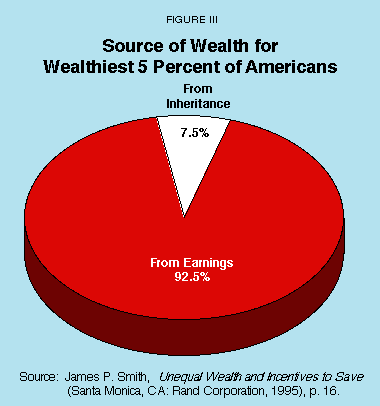
"The marginal tax rate on pension assets has risen to more than 85 percent – and con be as high as 99.73 percent in some states."
With intergenerational transfers accounting for as much as 80 percent of the nation's capital stock, according to a study by Laurence Kotlikoff and Lawrence Summers, this means that the estate tax is a direct tax on capital.16 Since the capital stock is the nation's wealth, it is reasonable to say that the nation's capital stock is automatically reduced by at least the amount of the tax. The effect on capital stock is even larger if it reduces the savings rate as well.17
Of course, anything that reduces capital formation in the economy ultimately makes everyone poorer. That is why economists historically have warned against estate taxes.
Adam Smith: "All taxes upon the transference of property of every kind, so far as they diminish the capital value of that property, tend to diminish the funds destined for the maintenance of productive labor."18
David Ricardo: "It should be the policy of governments…never to lay such taxes as will inevitably fall on capital; since by so doing, they impair the funds for the maintenance of labor, and thereby diminish the future production of the country."19
C.F. Bastable: "Succession duties first of all possess the grave economic fault of tending to fall on capital or accumulated wealth rather than on income; they therefore may retard progress."20
By contrast, those wishing to destroy the capitalist system have always been enthusiastic supporters of heavy estate taxes. It is worth remembering that the third plank of The Communist Manifesto says that the right of inheritance should be abolished.21 Even today, there are those who believe it is immoral to allow people to inherit anything.22
Ironically, the negative impact of the estate tax on saving and capital formation negates much of the redistributive effect of the tax. According to an article by Joseph Stiglitz, former chairman of the Council of Economic Advisers under President Clinton, to the extent that the estate tax lowers the capital stock it raises the return to the remaining capital. Since the rich already own most of the existing capital, the effect of the estate tax is to actually make them richer.23
Indeed, existing high estate tax rates appear to do virtually nothing to equalize the distribution of wealth.24 Recent studies, in fact, have argued that wealth has never been more unequal than it is today.25 One reason why estate taxes have less impact on wealth distribution than people imagine is that inheritances constitute less of the wealthy's assets than is usually thought. As Figure III shows, for those in the top 5 percent of the wealth distribution, inheritances make up only 7.5 percent of their wealth. Indeed, even among the super-rich, inheritance counts for less than commonly believed. According to one study, of the 265 separate fortunes represented by the Forbes 400, 157 or 59 percent were new wealth. Only 108 or 41 percent were inherited.26 Another study concluded that 75 percent to 85 percent of the rich throughout American history were self-made.27
"The impact of the estate tax on the distribution of wealth is limited because inheritances constitute little of most wealthy people's assets."Finally, the estate tax imposes large dead weight costs on the economy. First is the cost of employing large numbers of Internal Revenue Service agents to collect estate and gift taxes. Second is the cost of employing legions of tax lawyers to avoid the tax. Aaron and Munnell report that some 16,000 members of the American Bar Association cite trust, probate and estate law as their primary area of concentration. They conclude that compliance costs alone may eat up a sizable fraction of all estate tax revenues.28 On the other hand, one commentator has suggested that the government may get more revenue from taxing the incomes of estate tax planners than from the estate tax itself!29
[page]"Outright repeal is the best course, but it may not be politically feasible at this time."
Congress should consider these options:
Option 1. Repeal the estate and gift tax. Of course, outright repeal may not be politically feasible at this time. In that event, any of the efforts under way to reduce the estate tax by raising the exempt amount to $750,000 or $1 million merit support. Proposals that would target estate tax relief to family businesses, while worthy of support, are less desirable than repeal or increasing the exempt amount because they introduce further complexity to an already complex section of the Tax Code.
Option 2. Convert the estate tax credit to an exemption. This would reduce marginal estate tax rates for all estates under $3 million. Thus on the 600,001st dollar of taxable estate the tax rate would fall from 37 percent to 18 percent.
Option 3. Switch from an estate tax to an inheritance tax. Under the latter, estates would be taxed to the recipient, rather than in totality as at present. The virtue of this approach is that it actually would encourage wider distribution of wealth, because the tax would be lower when estates are broken up into a large number of pieces. To the extent that there is justification for using tax policy to prevent the concentration of wealth, this would work better than the current estate tax.30 This is the approach taken to transfer taxation by most other countries.31
Option 4. If it is necessary to raise alternative revenue to finance repeal of the estate tax, Congress might consider taxing capital gains at death instead. At present, the basis for all capital gains is stepped up at death. Thus capital gains held until death escape the capital gains tax altogether.32 The main problem with this is that it exacerbates the lock-in effect, which creates economic inefficiency.33 It means that new investments with greater growth potential are starved for capital because they are locked into older, underperforming assets that owners are reluctant to sell because of the capital gains tax. The result is that relative prices of capital assets are distorted, leading to the misallocation of investment. Taxing capital gains at death would raise as much or more revenue as the estate tax.34 This would create simplification by allowing one whole section of the Tax Code to be abolished, while lowering the top rate on assets held until death from 55 percent, the top estate tax rate, to 28 percent, currently the top rate on capital gains.
"A number of countries have already abolished the estate tax."
The estate tax is a bad tax. It raises little revenue. It does not redistribute wealth. It imposes large costs on the economy. And it is complicated and unfair. It should be abolished. In recent years a number of countries have done exactly that (see the Appendix). The United States should join them.35
NOTE: Nothing written here should be construed as necessarily reflecting the views of the National Center for Policy Analysis or as an attempt to aid or hinder the passage of any bill before Congress.
This Backgrounder is adapted from testimony June 12, 1997, before the Subcommittee on Tax, Finance and Exports of the U.S. House Committee on Small Business.
[page]- It is important to remember that the $600,000 estate tax exemption is not in fact an exemption. Taxpayers receive a credit of up to $192,800 on their estate tax liability. The effect of this is to exempt up to $600,000 of an estate from tax. Because of the difference between a true exemption and a credit, however, this means that no one actually pays the bottom estate tax rate of 18 percent. The marginal tax rate on the first dollar above $600,000 is in fact 37 percent.
- However, the Joint Committee on Taxation predicts that this percentage will rise to 2.64 percent of adult deaths by 2005. U.S. Congress, Joint Committee on Taxation, Description and Analysis of Proposals Relating to Estate and Gift Taxation, JCS-7-97 (Washington: U.S. Government Printing Office, 1997), p. 31.
- Even the popular press now discusses exotic estate planning techniques with regularity. See Louise Nameth, "Who Will Get Your Wealth: Your Kids or the IRS?" Fortune (March 17, 1997), p. 195-96; Christopher Drew and David Kay Johnston, "For Wealthy Americans, Death Is More certain Than Taxes," New York Times (December 22, 1996); Lynn Asinof, "Estate-Planning Techniques for the Rich," Wall Street Journal (January 11, 1995).
- George Cooper, A Voluntary Tax? New Perspectives on Sophisticated Estate Tax Avoidance (Washington: Brookings Institution, 1979), p. 4.
- Henry J. Aaron and Alicia H. Munnell, "Reassessing the Role for Wealth Transfer Taxes," National Tax Journal, vol. 45, no. 2 (June 1992), p. 138.
- Kenneth Chapman, Govind Hariharan and Lawrence Southwick, Jr., "Estate Taxes and Asset Accumulation," Family Business Review, vol. 9, no. 3 (Fall 1996), pp. 253-268.
- Christopher E. Erblich, "To Bury Federal Transfer Taxes Without Further Adieu," Seton Hall Law Review, vol. 24, no. 4 (1994), pp. 1953-56.
- Travis Research Associates, Federal Estate Tax Impact Survey (Costa Mesa, CA: Center for the Study of Taxation, June 1995).
- Douglas Holtz-Eakin, David Joulfaian, and Harvey Rosen, "Sticking It Out: Entrepreneurial Survival and Liquidity Constraints," Journal of Political Economy, vol. 102, no. 1 (February 1994), pp. 53-75. See also Patrick Fleenor and J.D. Foster, An Analysis of the Disincentive Effects of the Estate Tax on Entrepreneurship (Washington, DC: Tax Foundation, 1994).
- Chelcie C. Bosland, "Has Estate Taxation Induced Recent Mergers?" National Tax Journal, vol. 16, no. 2 (June 1963), pp. 159-168; Harold M. Somers, "Estate Taxes and Business Mergers: The Effects of Estate Taxes on Business Structure and Practices in the United States," Journal of Finance, vol. 13, no. 2 (May 1958), pp. 201-210.
- B. Douglas Bernheim, "Does the Estate Tax Raise Revenue?" in Lawrence H. Summers, ed., Tax Policy and the Economy, vol. 1 (Cambridge: MIT Press, 1987), pp. 113-138. It should also be noted that lawyers' and accountants' fees for estate planning can, in many cases, be deducted from one's income taxes, which is another way in which the estate tax reduces income tax revenues.
- Edward J. McCaffery, "The Uneasy Case for Wealth Transfer Taxation," Yale Law Journal, vol. 104, no. 2 (November 1994), pp. 319-321.
- Nigel Tomes, "The Family, Inheritance, and the Intergenerational Transmission of Inequality," Journal of Political Economy, vol. 89, no. 5 (October 1981), pp. 928-958; Jere R. Behrman, Robert A. Pollak, and Paul Taubman, "Parental Preferences and Provision for Progeny," Journal of Political Economy, vol. 90, no. 1 (February 1982), pp. 52-73.
- See B. Douglas Bernheim, Andrei Shleifer, and Lawrence H. Summers, "The Strategic Bequest Motive," Journal of Political Economy, vol. 93, no. 6 (December 1985), pp. 1045-76; Thad W. Mirer, "The Wealth-Age Relation among the Aged," American Economic Review, vol. 69, no. 3 (June 1979), pp. 435-443; Paul L. Menchik and Martin David, "Income Distribution, Lifetime Savings, and Bequests," American Economic Review, vol. 73, no. 4 (September 1983), pp. 672-690.
- John B. Shoven and David A. Wise, "The Taxation of Pensions: A Shelter Can Become a Trap," National Bureau of Economic Research Working Paper No. 5815 (November 1996).
- Laurence J. Kotlikoff and Lawrence H. Summers, "The Role of Intergenerational Transfers in Aggregate Capital Formation," Journal of Political Economy, vol. 89, no. 4 (August 1981), pp. 706-732. See also William G. Gale and John Karl Scholz, "Intergenerational Transfers and the Accumulation of Wealth," Journal of Economic Perspectives, vol. 8, no. 4 (Fall 1994), pp. 145-160; Thomas A. Barthold and Takatoshi Ito, "Bequest Taxes and Accumulation of Household Wealth: U.S.-Japan Comparison," in Takatoshi Ito and Anne O. Krueger, eds., The Political Economy of Tax Reform (Chicago: University of Chicago Press, 1992), pp. 235-290. Summers, a former Harvard economist, is now Deputy Secretary of the Tresury.
- Laurence Kotlikoff, "Intergenerational Transfers and Savings," Journal of Economic Perspectives, vol. 2, no. 2 (Spring 1988), pp. 41-58; B. Douglas Bernheim, "How Strong Are Bequest Motives? Evidence Based on Estimates of the Demand for Life Insurance and Annuities," Journal of Political Economy, vol. 99, no. 5 (October 1991), pp. 899-927.
- Adam Smith, The Wealth of Nations (New York: Modern Library, 1937), p. 814.
- David Ricardo, On the Principles of Political Economy and Taxation (New York: Cambridge University Press, 1951), p. 153.
- C.F. Bastable, Public Finance, 3rd ed. (London: Macmillan, 1903), p. 591.
- Karl Marx and Frederick Engels, The Communist Manifesto (New York: International Publishers, 1948), p. 30.
- D.W. Haslett, "Is Inheritance Justified?" Philosophy & Public Affairs, vol. 15, no. 2 (Spring 1986), pp. 122-155; Michael B. Levy, "Liberal Equality and Inherited Wealth," Political Theory, vol. 11, no. 4 (November 1983), pp. 545-564; Kenneth Greene, "Inheritance Unjustified?" Journal of Law & Economics, vol. 16, no. 2 (October 1973), pp. 417-419; Mark Ascher, "Curtailing Inherited Wealth," Michigan Law Review, vol. 89, no. 1 (October 1990), pp. 69-151.
- Joseph E. Stiglitz, "Notes on Estate Taxes, Redistribution, and the Concept of Balanced Growth Path Incidence," Journal of Political Economy, vol. 86, no. 2, pt. 2 (April 1978), pp. S137-S150.
- McCaffery, op. cit., pp. 322-324; Joel C. Dobris, "A Brief for the Abolition of All Transfer Taxes," Syracuse Law Review, vol. 35, no. 4 (1984), pp. 1219-1220; Alan S. Blinder, "Inequality and Mobility in the Distribution of Wealth," Kyklos, vol. 29, no. 4 (1976), pp. 618-19.
- Edward N. Wolff, Top Heavy, updated ed. (New York: The New Press, 1996).
- Rudolph C. Blitz and John J. Siegfried, "How Did the Wealthiest Americans Get So Rich?" Quarterly Review of Economics and Finance, vol. 32, no. 1 (Spring 1992), p. 9.
- Stanley Lebergott, The American Economy: Income, Wealth, and Want (Princeton, NJ: Princeton University Press, 1976), pp. 161-175.
- Aaron and Munnell, "Reassessing the Role for Wealth Transfer Taxes," p. 138.
- Gerald P. Moran, "Estate and Gift Taxation: The Case for Repeal," Tax Notes, vol. 13 (August 17, 1981), p. 341.
- Dan Throop Smith, Federal Tax Reform (New York: McGraw-Hill, 1961), pp. 294-296; George Guttman, "Change the Rules on Death and Taxes," Wall Street Journal (October 21, 1986). Alternatively, one could simply include gifts and inheritances in the taxable income of the recipient and avoid a separate inheritance tax altogether. Some commentators have suggested that this is the only correct way to tax inheritances. See H.C. Simons, Personal Income Taxation (Chicago: University of Chicago Press, 1938), pp. 125-147.
- Taxation of Net Wealth, Capital Transfers and Capital Gains of Individuals (Paris: Organization for Economic Cooperation and Development, 1988), p. 77; U.S. Congress, Joint Committee on Taxation, Issues Presented by Proposals to Modify the Tax Treatment of Expatriation, JCS-17-95 (Washington: U.S. Government Printing Office, 1995), p. C-1.
- For discussion, see Lawrence Zelenak, "Taxing Gains at Death," Vanderbilt Law Review, vol. 46 (March 1993), pp. 361-441; Joseph M. Dodge, "Further Thoughts on Realizing Gains and Losses at Death," Vanderbilt Law Review, vol. 47 (November 1994), pp. 1827-1861.
- Jonathan Brown, "The Locked-In Problem," in U.S. Congress, Joint Economic Committee, Federal Tax Policy for Economic Growth and Stability, 84th Congress, 1st session (Washington: U.S. Government Printing Office, 1955), pp. 367-381; Charles C. Holt and John P. Shelton, "The Lock-In Effect of the Capital Gains Tax," National Tax Journal, vol. 15, no. 4 (December 1962), pp. 337-352; Shlomo Yitzhaki, "An Empirical Test of the Lock-In Effect of the Capital Gains Tax," Review of Economics and Statistics, vol. 61, no. 4 (November 1979), pp. 626-629; Donald W. Kiefer, "Lock-In Effect Within a Simple Model of Corporate Stock Trading," National Tax Journal, vol. 43, no. 1 (March 1990), pp. 75-94.
- According to the Treasury Department, taxing capital gains at death would raise $30.7 billion in FY1997. However, the Joint Committee on Taxation estimates that it would raise only $15.5 billion. Office of Management and Budget, Budget of the United States Government, Fiscal Year 1998: Analytical Perspectives (Washington: U.S. Government Printing Office, 1997), p. 73; U.S. Congress, Joint Committee on Taxation, Estimates of Federal Tax Expenditures for Fiscal Years 1997-2001, JCS-11-96 (Washington: U.S. Government Printing Office, 1996), p. 19.
- A number of important tax theorists have called for repeal of the estate tax in recent years. In addition to the articles by McCaffery, Dobris, Moran and Erblich cited above, see Charles O. Galvin, "To Bury the Estate Tax, Not to Praise It," Tax Notes, vol. 52, no. 12 (September 16, 1991), pp. 1413-1419; Robert B. Smith, "Burying the Estate Tax Without Resurrecting Its Problems," Tax Notes, vol. 55, no. 13 (June 29, 1992), pp. 1799-1811; Edward McCaffery, "The Political Liberal Case Against the Estate Tax," Philosophy & Public Affairs, vol. 23, no. 4 (Fall 1994), pp. 281-312; Richard E. Wagner, Federal Transfer Taxation: A Study in Social Cost (Washington: Institute for Research on the Economics of Taxation, 1993); William W. Beach, "The Case for Repealing the Estate Tax," Heritage Foundation Backgrounder no. 1091 (August 21, 1996).
